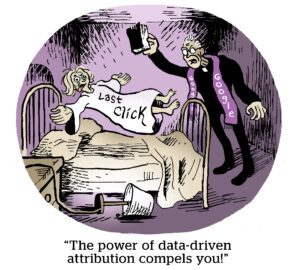Privacy is hotter than a habanero right now – and it’s coming for your ads.
The zeitgeist has turned. Despite recent protests to the contrary, the FTC embraces “surveillance” as a metaphor for ad tech, and the cultural elite is even less happy. A recent op-ed in the New York Times, by Julia Angwin, implicated the industry in many dismal practices, including election-rigging, news-defunding and even inflation.
It’s difficult to find anyone willing to make a case for the defense. If someone were to do it, they might start with these four myths.
1. Advertisers Follow You Around the Web
Only the phone company and your browser can follow you around the web. Angwin claimed: “Tech firms track nearly every click from website to website.” It would surprise her to learn the vast majority of clicks on the web are neither tracked by advertisers nor available for sale.
Take retargeting, the best-case scenario (or worst-case, depending on your POV). That’s the classic example of the shoes that followed me around, etc. What does the retargeter know? That (1) your browser loaded a particular item, (2) that browser is now on a publisher’s site. That’s it. Better than nothing – but far from a map of your entire web journey.
And by the way, that advertiser has no idea who you are (unless you told them). You’re anonymous. Contrast this with the offline world, where it’s easy to get a file of recent movers, say, from the US Postal Service, and they’re not anonymous.
2. Targeted Ads Hurt Publishers
This is the easiest claim to debunk. Certainly, the internet itself has been hard on print, as cable and streaming services have bopped linear television. Global revenue for newspapers is down by two-thirds in two decades, and this is not good news for anyone.
Targeted ads did not cause this decline; the internet did. For whatever reason, online ads don’t command the same prices as offline ads per impression. But if you’d like to find a better culprit, look at Craigslist. For decades, classified ads were a cash cow for publishers, particularly local papers. Classified ad revenue for US newspapers fell from $20 billion to $2 billion in the last two decades.
Any publisher will tell you targeted ads are usually worth more per impression than less-targeted ads. Better targeting makes ads more relevant; more relevant ads are more likely to get a response; that response is worth more to an advertiser. It’s just math. There’s a reason ad targeting happened.
Big publishers are the most vocal defenders of targeted ads. Some of them, like Axel Springer, are even going to court to try to save the cookie.
3. Targeted Ads Hurt People
The challenge here is in finding a harm caused by targeting – and not just by ads in general or by an unethical advertiser who is violating existing consumer or other protections.
For example, a recent study out of Carnegie Mellon concluded that products shown in digital ads were lower quality compared to search. The study is quite puzzling: Display and search work very differently, and it’s difficult to see how a consumer is actually hurt by seeing an ad for a cheaply made product.
Higher-margin products – from Veg-O-Matic to class-action lawsuits – always advertise. They’re what keep late-night cable TV and the Home Shopping Network in business. As consumers, we’re free to make our own choices.
More seriously, targeted ads are blamed for tipping elections and spreading falsehoods. The Ban Surveillance Advertising Act, proposed last year, said: “It fuels disinformation, discrimination, voter suppression, privacy abuses, and so many other harms.” Again, no specific instances are raised, and there is ample evidence that ads alone don’t tip elections anyway.
If the advertiser is selling a harmful product or lying, that’s the responsibility of the FTC and Truth in Advertising. We all remember smoking ads, or at least saw Mad Men. None of those were “microtargeted.”
4. Eliminating Targeting Eliminates Tracking
Since Chrome announced the deprecation of the you-know-what three years ago, there’s been a shift toward first-party data. Brands try to get more of it; tech companies build tools to move it along. It all makes perfect sense.
The winners are companies with their own troves of first-party data. Large retailers are loving retail media. These players naturally know what you do on their sites, combine it with other data and insights, and package it up for advertisers. They got an opt-in sometime a while back. (It’s in the T&Cs.)
Yet that’s not “surveillance.” Nor is search, although it might surprise critics to learn that search data – often more personal than cookie data – is observed and sometimes informs ad targeting.
It seems that third-party data collection (retargeting shoes) is a convenient target for angst when the far more potent profiles and power lies with these growing first parties.
One Bad Thing About Targeted Ads
Third-party cookies need a reset; they were not designed for ad tech anyway. Few defend pixel-synching in its current state. Ironically, the bad thing about targeted ads is that they aren’t subtle. They’re often lower funnel, so they tend to be less creatively appealing anyway.
And they’re part of a system that doesn’t have a handle on phenomena that bother consumers. Take frequency capping, the scourge of CTV. That’s a symptom of a system not knowing enough about (anonymous) consumers, rather than the opposite.
Nobody’s defending invasion of privacy or unethical ads. But it’s time to put up some kind of defense for basic ad targeting, before it’s too late.
“Data-Driven Thinking” is written by members of the media community and contains fresh ideas on the digital revolution in media.
Follow Salesforce and AdExchanger on LinkedIn.
For more articles featuring Martin Kihn, click here.















